BSBSUS501: Questions on Developing Workplace Sustainability Policies
VerifiedAdded on 2022/11/13
|45
|12088
|254
Homework Assignment
AI Summary
This document presents answers to a series of questions related to the BSBSUS501 Develop workplace policy and procedures for sustainability assignment. The responses cover various aspects of sustainability, including the Kyoto Protocol and Australia's obligations, the Asia-Pacific Partnership on Clean Development and Climate, and the Environment Protection and Biodiversity Conservation Act (EPBC Act). It also outlines the National Greenhouse and Energy Reporting Scheme, the Australian Packaging Covenant, and the Australian Ecolabel Program. The document further explores internal and external information sources for developing sustainability policies, key steps in the policy development process, and the main components of a policy document. It also addresses policy development practices to manage resistance, the rationale for implementing an environmental management system (EMS), and its key components. The assignment provides comprehensive insights into workplace sustainability policies and procedures.
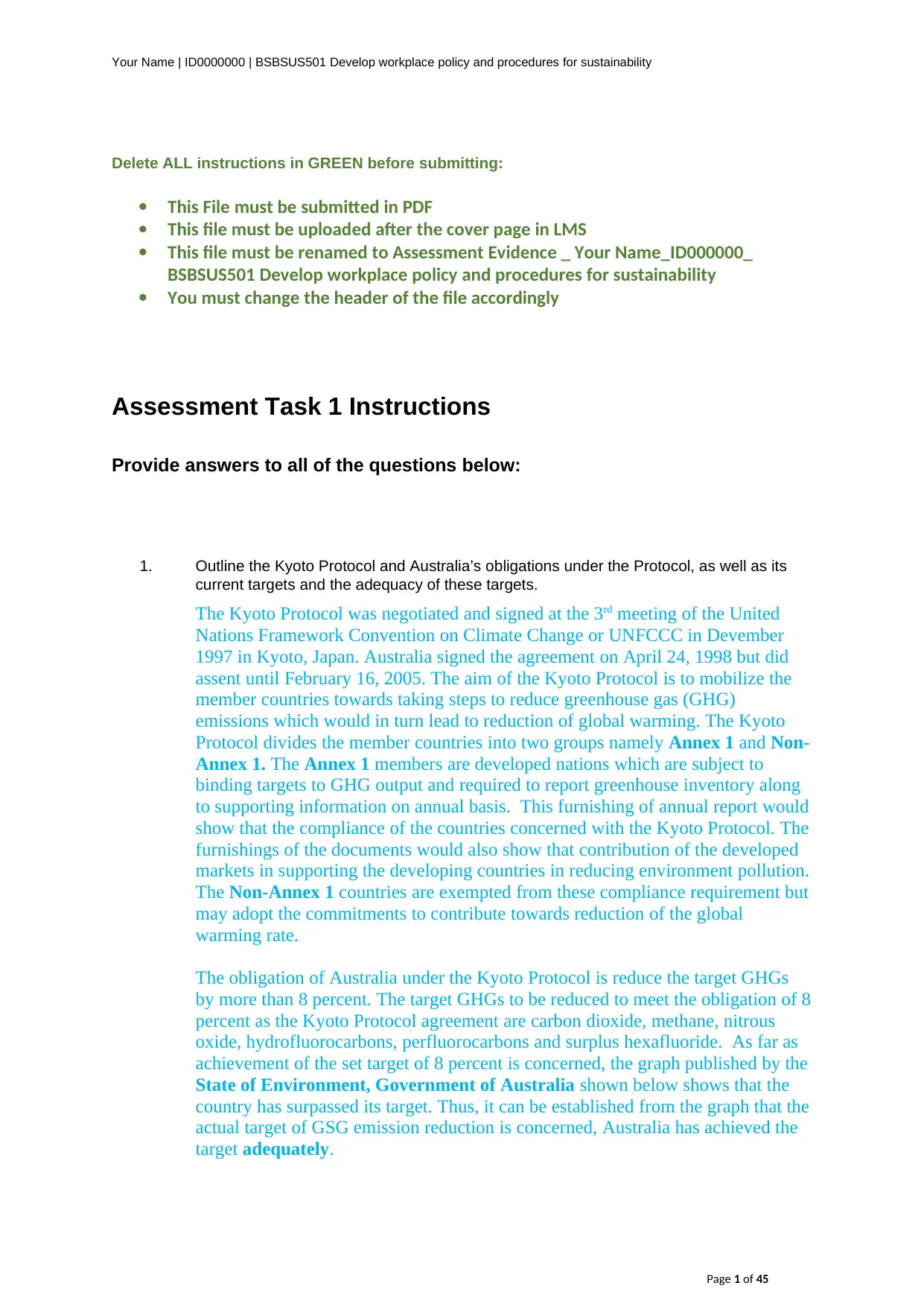
Your Name | ID0000000 | BSBSUS501 Develop workplace policy and procedures for sustainability
Delete ALL instructions in GREEN before submitting:
This File must be submitted in PDF
This file must be uploaded after the cover page in LMS
This file must be renamed to Assessment Evidence _ Your Name_ID000000_
BSBSUS501 Develop workplace policy and procedures for sustainability
You must change the header of the file accordingly
Assessment Task 1 Instructions
Provide answers to all of the questions below:
1. Outline the Kyoto Protocol and Australia’s obligations under the Protocol, as well as its
current targets and the adequacy of these targets.
The Kyoto Protocol was negotiated and signed at the 3rd meeting of the United
Nations Framework Convention on Climate Change or UNFCCC in Devember
1997 in Kyoto, Japan. Australia signed the agreement on April 24, 1998 but did
assent until February 16, 2005. The aim of the Kyoto Protocol is to mobilize the
member countries towards taking steps to reduce greenhouse gas (GHG)
emissions which would in turn lead to reduction of global warming. The Kyoto
Protocol divides the member countries into two groups namely Annex 1 and Non-
Annex 1. The Annex 1 members are developed nations which are subject to
binding targets to GHG output and required to report greenhouse inventory along
to supporting information on annual basis. This furnishing of annual report would
show that the compliance of the countries concerned with the Kyoto Protocol. The
furnishings of the documents would also show that contribution of the developed
markets in supporting the developing countries in reducing environment pollution.
The Non-Annex 1 countries are exempted from these compliance requirement but
may adopt the commitments to contribute towards reduction of the global
warming rate.
The obligation of Australia under the Kyoto Protocol is reduce the target GHGs
by more than 8 percent. The target GHGs to be reduced to meet the obligation of 8
percent as the Kyoto Protocol agreement are carbon dioxide, methane, nitrous
oxide, hydrofluorocarbons, perfluorocarbons and surplus hexafluoride. As far as
achievement of the set target of 8 percent is concerned, the graph published by the
State of Environment, Government of Australia shown below shows that the
country has surpassed its target. Thus, it can be established from the graph that the
actual target of GSG emission reduction is concerned, Australia has achieved the
target adequately.
Page 1 of 45
Delete ALL instructions in GREEN before submitting:
This File must be submitted in PDF
This file must be uploaded after the cover page in LMS
This file must be renamed to Assessment Evidence _ Your Name_ID000000_
BSBSUS501 Develop workplace policy and procedures for sustainability
You must change the header of the file accordingly
Assessment Task 1 Instructions
Provide answers to all of the questions below:
1. Outline the Kyoto Protocol and Australia’s obligations under the Protocol, as well as its
current targets and the adequacy of these targets.
The Kyoto Protocol was negotiated and signed at the 3rd meeting of the United
Nations Framework Convention on Climate Change or UNFCCC in Devember
1997 in Kyoto, Japan. Australia signed the agreement on April 24, 1998 but did
assent until February 16, 2005. The aim of the Kyoto Protocol is to mobilize the
member countries towards taking steps to reduce greenhouse gas (GHG)
emissions which would in turn lead to reduction of global warming. The Kyoto
Protocol divides the member countries into two groups namely Annex 1 and Non-
Annex 1. The Annex 1 members are developed nations which are subject to
binding targets to GHG output and required to report greenhouse inventory along
to supporting information on annual basis. This furnishing of annual report would
show that the compliance of the countries concerned with the Kyoto Protocol. The
furnishings of the documents would also show that contribution of the developed
markets in supporting the developing countries in reducing environment pollution.
The Non-Annex 1 countries are exempted from these compliance requirement but
may adopt the commitments to contribute towards reduction of the global
warming rate.
The obligation of Australia under the Kyoto Protocol is reduce the target GHGs
by more than 8 percent. The target GHGs to be reduced to meet the obligation of 8
percent as the Kyoto Protocol agreement are carbon dioxide, methane, nitrous
oxide, hydrofluorocarbons, perfluorocarbons and surplus hexafluoride. As far as
achievement of the set target of 8 percent is concerned, the graph published by the
State of Environment, Government of Australia shown below shows that the
country has surpassed its target. Thus, it can be established from the graph that the
actual target of GSG emission reduction is concerned, Australia has achieved the
target adequately.
Page 1 of 45
Paraphrase This Document
Need a fresh take? Get an instant paraphrase of this document with our AI Paraphraser
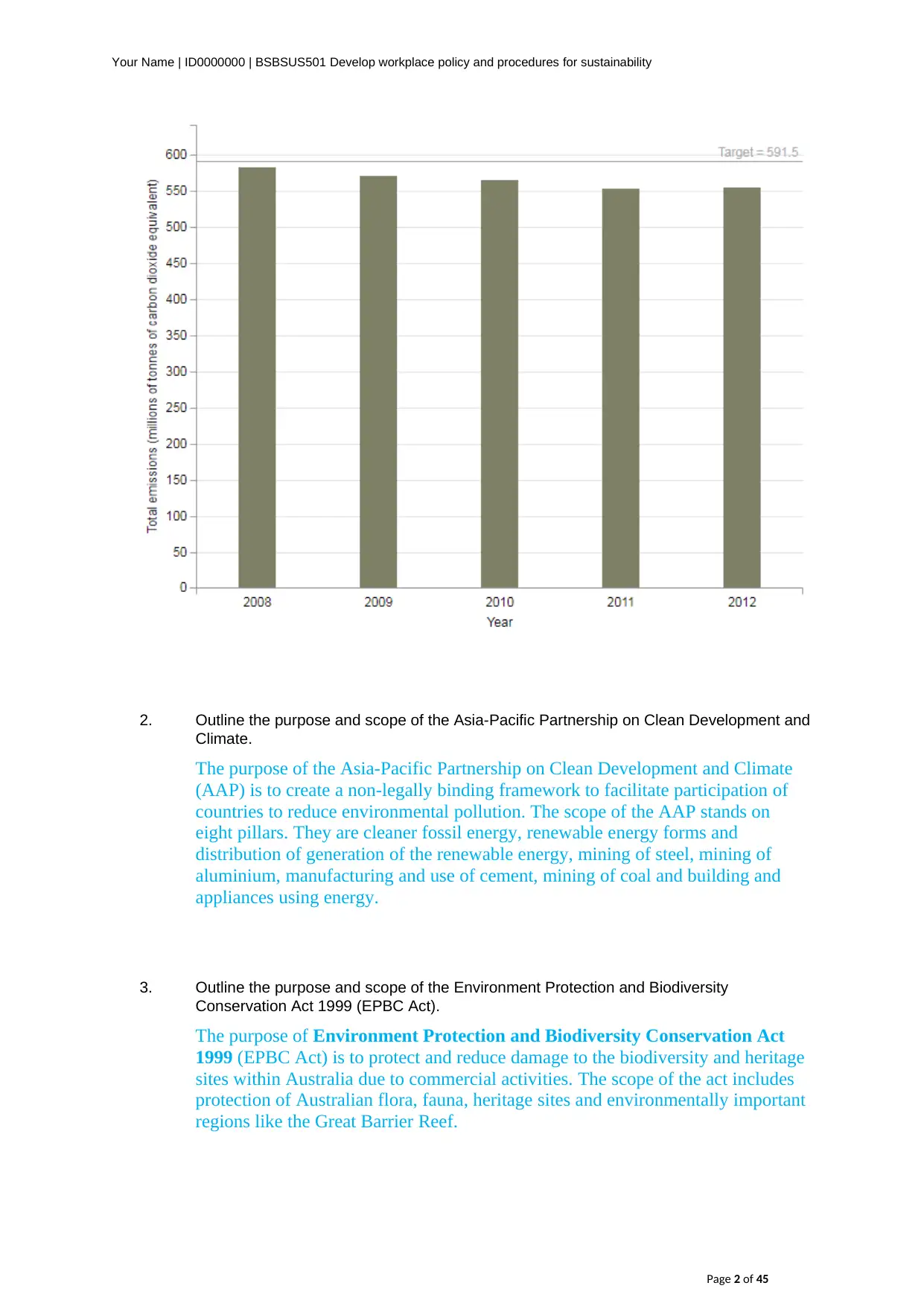
Your Name | ID0000000 | BSBSUS501 Develop workplace policy and procedures for sustainability
2. Outline the purpose and scope of the Asia-Pacific Partnership on Clean Development and
Climate.
The purpose of the Asia-Pacific Partnership on Clean Development and Climate
(AAP) is to create a non-legally binding framework to facilitate participation of
countries to reduce environmental pollution. The scope of the AAP stands on
eight pillars. They are cleaner fossil energy, renewable energy forms and
distribution of generation of the renewable energy, mining of steel, mining of
aluminium, manufacturing and use of cement, mining of coal and building and
appliances using energy.
3. Outline the purpose and scope of the Environment Protection and Biodiversity
Conservation Act 1999 (EPBC Act).
The purpose of Environment Protection and Biodiversity Conservation Act
1999 (EPBC Act) is to protect and reduce damage to the biodiversity and heritage
sites within Australia due to commercial activities. The scope of the act includes
protection of Australian flora, fauna, heritage sites and environmentally important
regions like the Great Barrier Reef.
Page 2 of 45
2. Outline the purpose and scope of the Asia-Pacific Partnership on Clean Development and
Climate.
The purpose of the Asia-Pacific Partnership on Clean Development and Climate
(AAP) is to create a non-legally binding framework to facilitate participation of
countries to reduce environmental pollution. The scope of the AAP stands on
eight pillars. They are cleaner fossil energy, renewable energy forms and
distribution of generation of the renewable energy, mining of steel, mining of
aluminium, manufacturing and use of cement, mining of coal and building and
appliances using energy.
3. Outline the purpose and scope of the Environment Protection and Biodiversity
Conservation Act 1999 (EPBC Act).
The purpose of Environment Protection and Biodiversity Conservation Act
1999 (EPBC Act) is to protect and reduce damage to the biodiversity and heritage
sites within Australia due to commercial activities. The scope of the act includes
protection of Australian flora, fauna, heritage sites and environmentally important
regions like the Great Barrier Reef.
Page 2 of 45
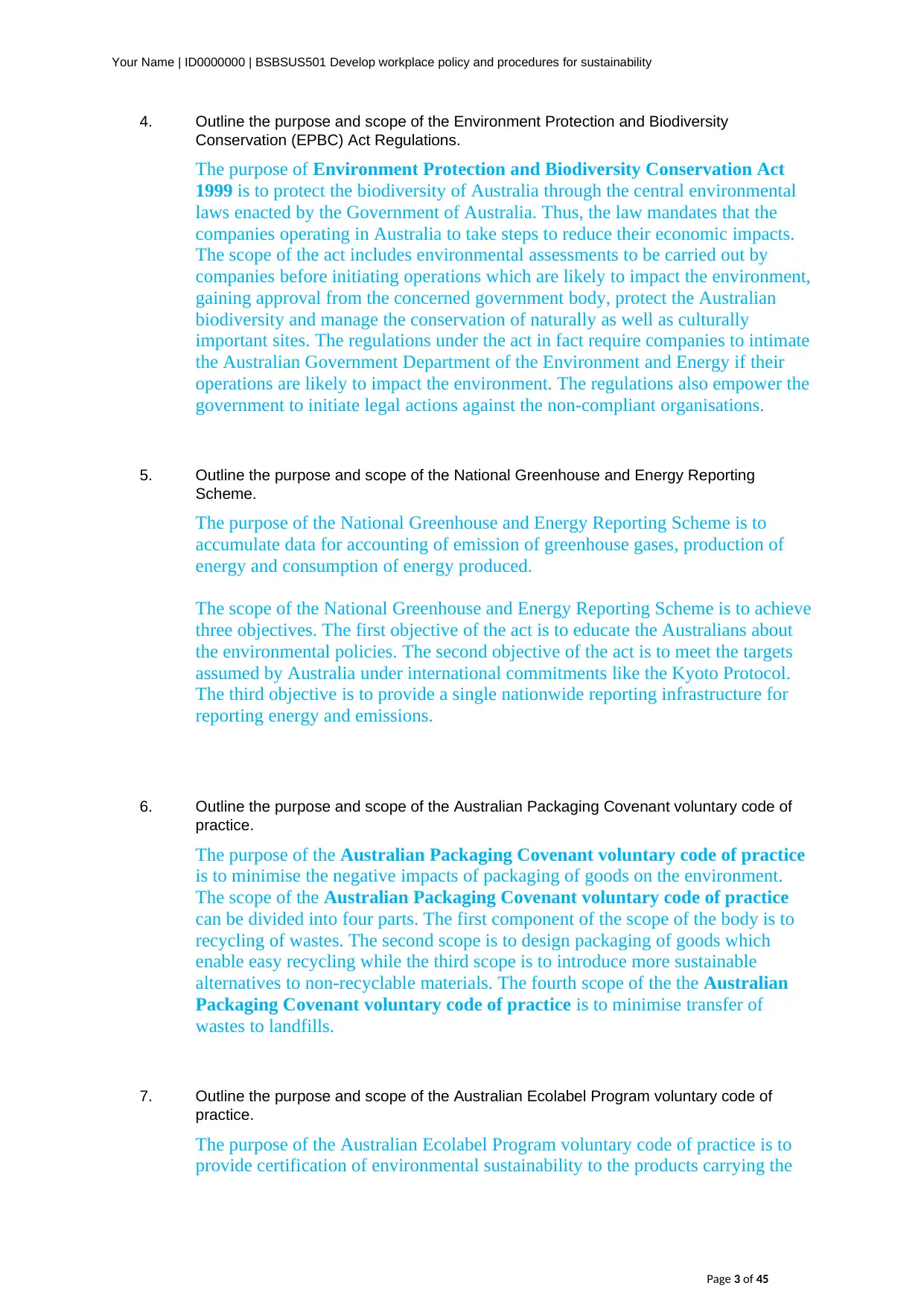
Your Name | ID0000000 | BSBSUS501 Develop workplace policy and procedures for sustainability
4. Outline the purpose and scope of the Environment Protection and Biodiversity
Conservation (EPBC) Act Regulations.
The purpose of Environment Protection and Biodiversity Conservation Act
1999 is to protect the biodiversity of Australia through the central environmental
laws enacted by the Government of Australia. Thus, the law mandates that the
companies operating in Australia to take steps to reduce their economic impacts.
The scope of the act includes environmental assessments to be carried out by
companies before initiating operations which are likely to impact the environment,
gaining approval from the concerned government body, protect the Australian
biodiversity and manage the conservation of naturally as well as culturally
important sites. The regulations under the act in fact require companies to intimate
the Australian Government Department of the Environment and Energy if their
operations are likely to impact the environment. The regulations also empower the
government to initiate legal actions against the non-compliant organisations.
5. Outline the purpose and scope of the National Greenhouse and Energy Reporting
Scheme.
The purpose of the National Greenhouse and Energy Reporting Scheme is to
accumulate data for accounting of emission of greenhouse gases, production of
energy and consumption of energy produced.
The scope of the National Greenhouse and Energy Reporting Scheme is to achieve
three objectives. The first objective of the act is to educate the Australians about
the environmental policies. The second objective of the act is to meet the targets
assumed by Australia under international commitments like the Kyoto Protocol.
The third objective is to provide a single nationwide reporting infrastructure for
reporting energy and emissions.
6. Outline the purpose and scope of the Australian Packaging Covenant voluntary code of
practice.
The purpose of the Australian Packaging Covenant voluntary code of practice
is to minimise the negative impacts of packaging of goods on the environment.
The scope of the Australian Packaging Covenant voluntary code of practice
can be divided into four parts. The first component of the scope of the body is to
recycling of wastes. The second scope is to design packaging of goods which
enable easy recycling while the third scope is to introduce more sustainable
alternatives to non-recyclable materials. The fourth scope of the the Australian
Packaging Covenant voluntary code of practice is to minimise transfer of
wastes to landfills.
7. Outline the purpose and scope of the Australian Ecolabel Program voluntary code of
practice.
The purpose of the Australian Ecolabel Program voluntary code of practice is to
provide certification of environmental sustainability to the products carrying the
Page 3 of 45
4. Outline the purpose and scope of the Environment Protection and Biodiversity
Conservation (EPBC) Act Regulations.
The purpose of Environment Protection and Biodiversity Conservation Act
1999 is to protect the biodiversity of Australia through the central environmental
laws enacted by the Government of Australia. Thus, the law mandates that the
companies operating in Australia to take steps to reduce their economic impacts.
The scope of the act includes environmental assessments to be carried out by
companies before initiating operations which are likely to impact the environment,
gaining approval from the concerned government body, protect the Australian
biodiversity and manage the conservation of naturally as well as culturally
important sites. The regulations under the act in fact require companies to intimate
the Australian Government Department of the Environment and Energy if their
operations are likely to impact the environment. The regulations also empower the
government to initiate legal actions against the non-compliant organisations.
5. Outline the purpose and scope of the National Greenhouse and Energy Reporting
Scheme.
The purpose of the National Greenhouse and Energy Reporting Scheme is to
accumulate data for accounting of emission of greenhouse gases, production of
energy and consumption of energy produced.
The scope of the National Greenhouse and Energy Reporting Scheme is to achieve
three objectives. The first objective of the act is to educate the Australians about
the environmental policies. The second objective of the act is to meet the targets
assumed by Australia under international commitments like the Kyoto Protocol.
The third objective is to provide a single nationwide reporting infrastructure for
reporting energy and emissions.
6. Outline the purpose and scope of the Australian Packaging Covenant voluntary code of
practice.
The purpose of the Australian Packaging Covenant voluntary code of practice
is to minimise the negative impacts of packaging of goods on the environment.
The scope of the Australian Packaging Covenant voluntary code of practice
can be divided into four parts. The first component of the scope of the body is to
recycling of wastes. The second scope is to design packaging of goods which
enable easy recycling while the third scope is to introduce more sustainable
alternatives to non-recyclable materials. The fourth scope of the the Australian
Packaging Covenant voluntary code of practice is to minimise transfer of
wastes to landfills.
7. Outline the purpose and scope of the Australian Ecolabel Program voluntary code of
practice.
The purpose of the Australian Ecolabel Program voluntary code of practice is to
provide certification of environmental sustainability to the products carrying the
Page 3 of 45
⊘ This is a preview!⊘
Do you want full access?
Subscribe today to unlock all pages.

Trusted by 1+ million students worldwide
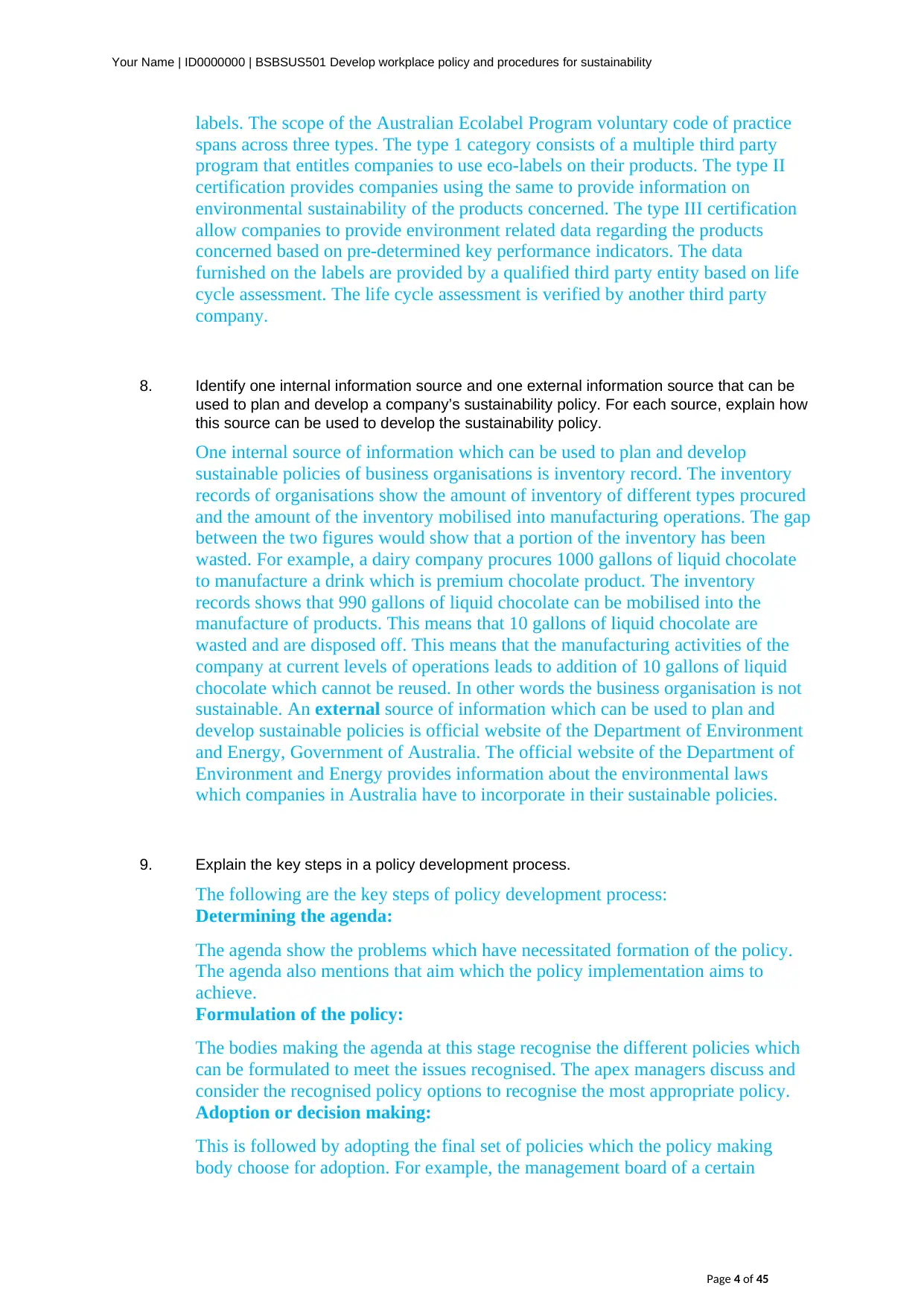
Your Name | ID0000000 | BSBSUS501 Develop workplace policy and procedures for sustainability
labels. The scope of the Australian Ecolabel Program voluntary code of practice
spans across three types. The type 1 category consists of a multiple third party
program that entitles companies to use eco-labels on their products. The type II
certification provides companies using the same to provide information on
environmental sustainability of the products concerned. The type III certification
allow companies to provide environment related data regarding the products
concerned based on pre-determined key performance indicators. The data
furnished on the labels are provided by a qualified third party entity based on life
cycle assessment. The life cycle assessment is verified by another third party
company.
8. Identify one internal information source and one external information source that can be
used to plan and develop a company’s sustainability policy. For each source, explain how
this source can be used to develop the sustainability policy.
One internal source of information which can be used to plan and develop
sustainable policies of business organisations is inventory record. The inventory
records of organisations show the amount of inventory of different types procured
and the amount of the inventory mobilised into manufacturing operations. The gap
between the two figures would show that a portion of the inventory has been
wasted. For example, a dairy company procures 1000 gallons of liquid chocolate
to manufacture a drink which is premium chocolate product. The inventory
records shows that 990 gallons of liquid chocolate can be mobilised into the
manufacture of products. This means that 10 gallons of liquid chocolate are
wasted and are disposed off. This means that the manufacturing activities of the
company at current levels of operations leads to addition of 10 gallons of liquid
chocolate which cannot be reused. In other words the business organisation is not
sustainable. An external source of information which can be used to plan and
develop sustainable policies is official website of the Department of Environment
and Energy, Government of Australia. The official website of the Department of
Environment and Energy provides information about the environmental laws
which companies in Australia have to incorporate in their sustainable policies.
9. Explain the key steps in a policy development process.
The following are the key steps of policy development process:
Determining the agenda:
The agenda show the problems which have necessitated formation of the policy.
The agenda also mentions that aim which the policy implementation aims to
achieve.
Formulation of the policy:
The bodies making the agenda at this stage recognise the different policies which
can be formulated to meet the issues recognised. The apex managers discuss and
consider the recognised policy options to recognise the most appropriate policy.
Adoption or decision making:
This is followed by adopting the final set of policies which the policy making
body choose for adoption. For example, the management board of a certain
Page 4 of 45
labels. The scope of the Australian Ecolabel Program voluntary code of practice
spans across three types. The type 1 category consists of a multiple third party
program that entitles companies to use eco-labels on their products. The type II
certification provides companies using the same to provide information on
environmental sustainability of the products concerned. The type III certification
allow companies to provide environment related data regarding the products
concerned based on pre-determined key performance indicators. The data
furnished on the labels are provided by a qualified third party entity based on life
cycle assessment. The life cycle assessment is verified by another third party
company.
8. Identify one internal information source and one external information source that can be
used to plan and develop a company’s sustainability policy. For each source, explain how
this source can be used to develop the sustainability policy.
One internal source of information which can be used to plan and develop
sustainable policies of business organisations is inventory record. The inventory
records of organisations show the amount of inventory of different types procured
and the amount of the inventory mobilised into manufacturing operations. The gap
between the two figures would show that a portion of the inventory has been
wasted. For example, a dairy company procures 1000 gallons of liquid chocolate
to manufacture a drink which is premium chocolate product. The inventory
records shows that 990 gallons of liquid chocolate can be mobilised into the
manufacture of products. This means that 10 gallons of liquid chocolate are
wasted and are disposed off. This means that the manufacturing activities of the
company at current levels of operations leads to addition of 10 gallons of liquid
chocolate which cannot be reused. In other words the business organisation is not
sustainable. An external source of information which can be used to plan and
develop sustainable policies is official website of the Department of Environment
and Energy, Government of Australia. The official website of the Department of
Environment and Energy provides information about the environmental laws
which companies in Australia have to incorporate in their sustainable policies.
9. Explain the key steps in a policy development process.
The following are the key steps of policy development process:
Determining the agenda:
The agenda show the problems which have necessitated formation of the policy.
The agenda also mentions that aim which the policy implementation aims to
achieve.
Formulation of the policy:
The bodies making the agenda at this stage recognise the different policies which
can be formulated to meet the issues recognised. The apex managers discuss and
consider the recognised policy options to recognise the most appropriate policy.
Adoption or decision making:
This is followed by adopting the final set of policies which the policy making
body choose for adoption. For example, the management board of a certain
Page 4 of 45
Paraphrase This Document
Need a fresh take? Get an instant paraphrase of this document with our AI Paraphraser
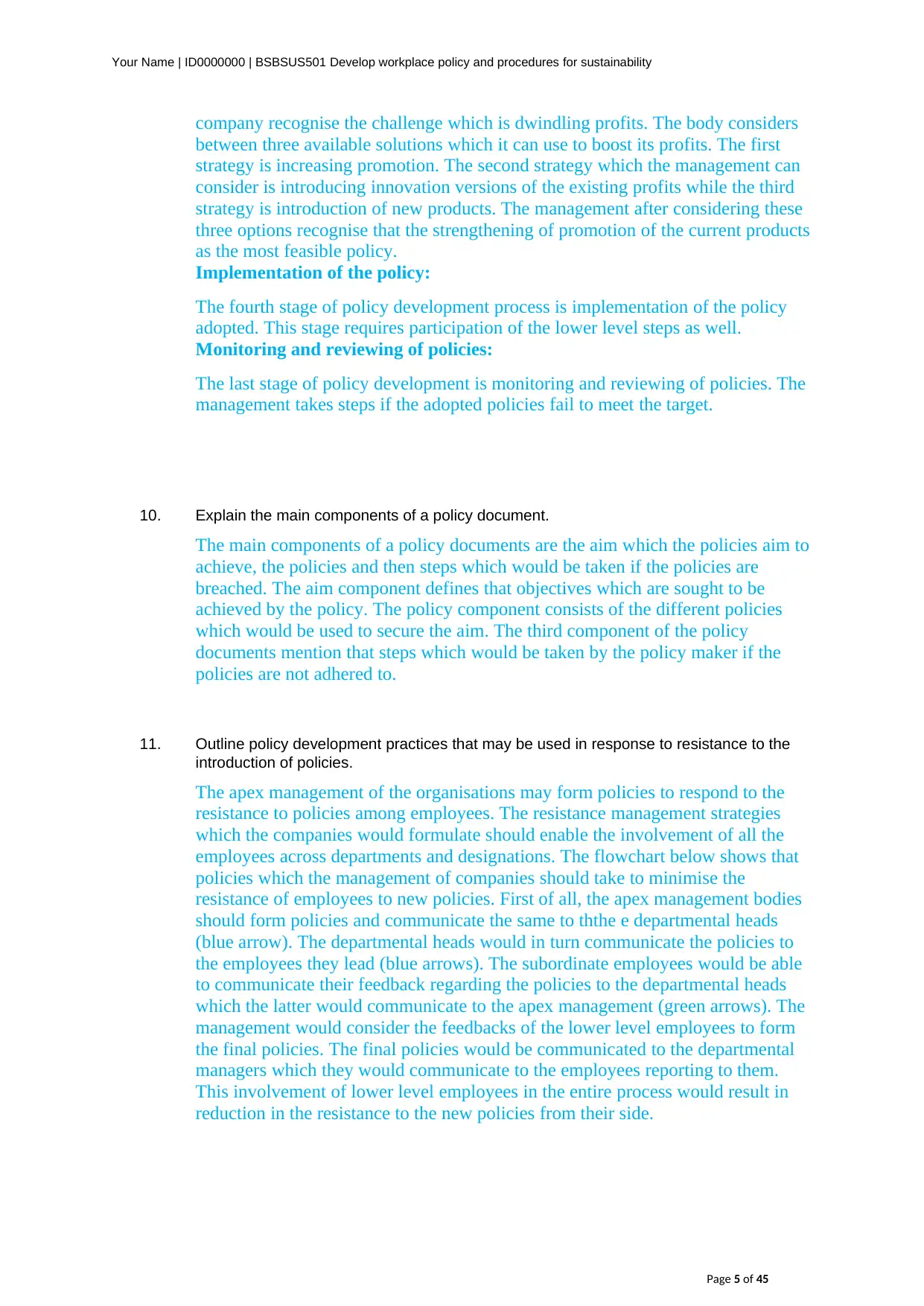
Your Name | ID0000000 | BSBSUS501 Develop workplace policy and procedures for sustainability
company recognise the challenge which is dwindling profits. The body considers
between three available solutions which it can use to boost its profits. The first
strategy is increasing promotion. The second strategy which the management can
consider is introducing innovation versions of the existing profits while the third
strategy is introduction of new products. The management after considering these
three options recognise that the strengthening of promotion of the current products
as the most feasible policy.
Implementation of the policy:
The fourth stage of policy development process is implementation of the policy
adopted. This stage requires participation of the lower level steps as well.
Monitoring and reviewing of policies:
The last stage of policy development is monitoring and reviewing of policies. The
management takes steps if the adopted policies fail to meet the target.
10. Explain the main components of a policy document.
The main components of a policy documents are the aim which the policies aim to
achieve, the policies and then steps which would be taken if the policies are
breached. The aim component defines that objectives which are sought to be
achieved by the policy. The policy component consists of the different policies
which would be used to secure the aim. The third component of the policy
documents mention that steps which would be taken by the policy maker if the
policies are not adhered to.
11. Outline policy development practices that may be used in response to resistance to the
introduction of policies.
The apex management of the organisations may form policies to respond to the
resistance to policies among employees. The resistance management strategies
which the companies would formulate should enable the involvement of all the
employees across departments and designations. The flowchart below shows that
policies which the management of companies should take to minimise the
resistance of employees to new policies. First of all, the apex management bodies
should form policies and communicate the same to ththe e departmental heads
(blue arrow). The departmental heads would in turn communicate the policies to
the employees they lead (blue arrows). The subordinate employees would be able
to communicate their feedback regarding the policies to the departmental heads
which the latter would communicate to the apex management (green arrows). The
management would consider the feedbacks of the lower level employees to form
the final policies. The final policies would be communicated to the departmental
managers which they would communicate to the employees reporting to them.
This involvement of lower level employees in the entire process would result in
reduction in the resistance to the new policies from their side.
Page 5 of 45
company recognise the challenge which is dwindling profits. The body considers
between three available solutions which it can use to boost its profits. The first
strategy is increasing promotion. The second strategy which the management can
consider is introducing innovation versions of the existing profits while the third
strategy is introduction of new products. The management after considering these
three options recognise that the strengthening of promotion of the current products
as the most feasible policy.
Implementation of the policy:
The fourth stage of policy development process is implementation of the policy
adopted. This stage requires participation of the lower level steps as well.
Monitoring and reviewing of policies:
The last stage of policy development is monitoring and reviewing of policies. The
management takes steps if the adopted policies fail to meet the target.
10. Explain the main components of a policy document.
The main components of a policy documents are the aim which the policies aim to
achieve, the policies and then steps which would be taken if the policies are
breached. The aim component defines that objectives which are sought to be
achieved by the policy. The policy component consists of the different policies
which would be used to secure the aim. The third component of the policy
documents mention that steps which would be taken by the policy maker if the
policies are not adhered to.
11. Outline policy development practices that may be used in response to resistance to the
introduction of policies.
The apex management of the organisations may form policies to respond to the
resistance to policies among employees. The resistance management strategies
which the companies would formulate should enable the involvement of all the
employees across departments and designations. The flowchart below shows that
policies which the management of companies should take to minimise the
resistance of employees to new policies. First of all, the apex management bodies
should form policies and communicate the same to ththe e departmental heads
(blue arrow). The departmental heads would in turn communicate the policies to
the employees they lead (blue arrows). The subordinate employees would be able
to communicate their feedback regarding the policies to the departmental heads
which the latter would communicate to the apex management (green arrows). The
management would consider the feedbacks of the lower level employees to form
the final policies. The final policies would be communicated to the departmental
managers which they would communicate to the employees reporting to them.
This involvement of lower level employees in the entire process would result in
reduction in the resistance to the new policies from their side.
Page 5 of 45
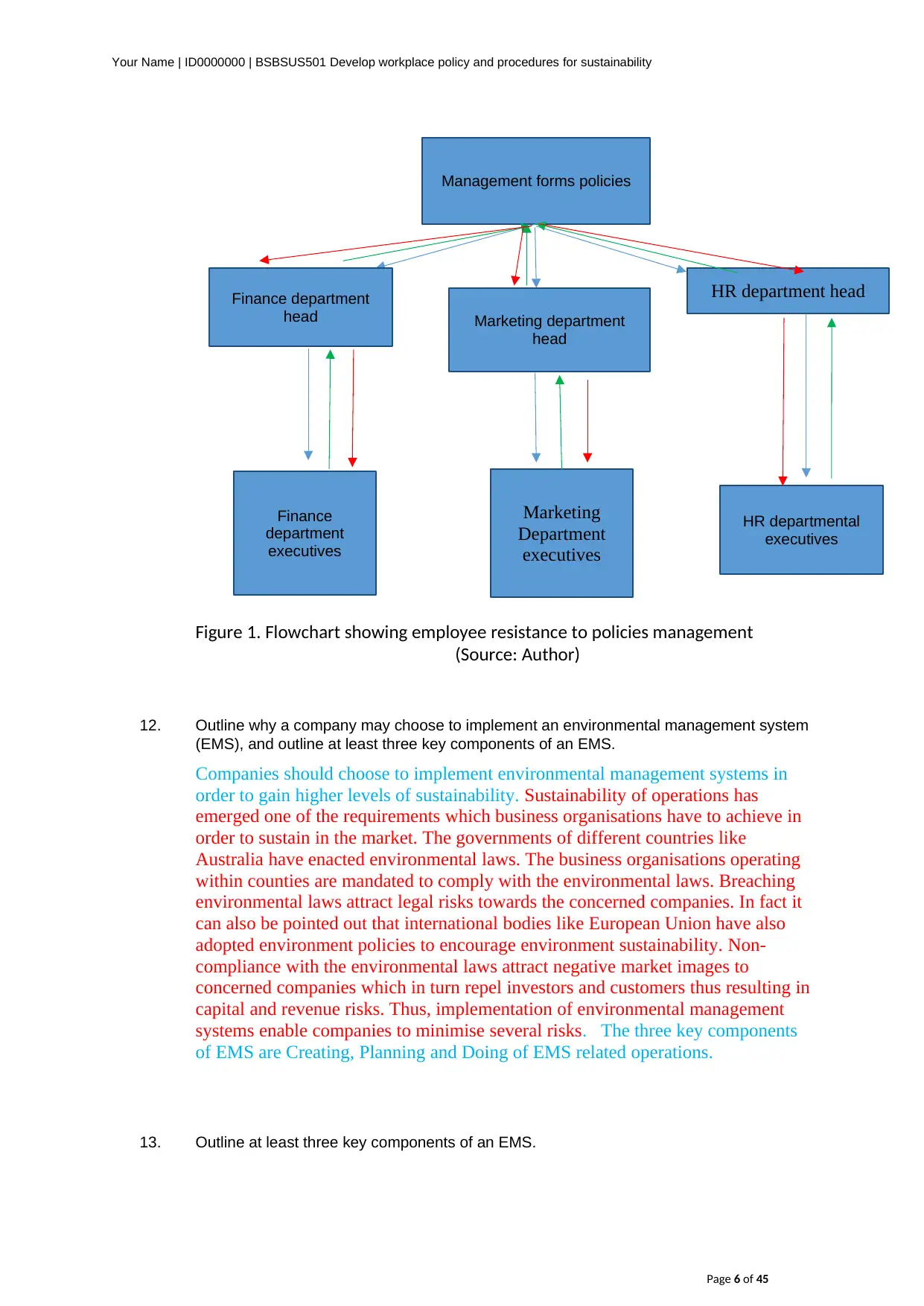
Management forms policies
Finance department
head Marketing department
head
HR department head
Finance
department
executives
Marketing
Department
executives
HR departmental
executives
Your Name | ID0000000 | BSBSUS501 Develop workplace policy and procedures for sustainability
Figure 1. Flowchart showing employee resistance to policies management
(Source: Author)
12. Outline why a company may choose to implement an environmental management system
(EMS), and outline at least three key components of an EMS.
Companies should choose to implement environmental management systems in
order to gain higher levels of sustainability. Sustainability of operations has
emerged one of the requirements which business organisations have to achieve in
order to sustain in the market. The governments of different countries like
Australia have enacted environmental laws. The business organisations operating
within counties are mandated to comply with the environmental laws. Breaching
environmental laws attract legal risks towards the concerned companies. In fact it
can also be pointed out that international bodies like European Union have also
adopted environment policies to encourage environment sustainability. Non-
compliance with the environmental laws attract negative market images to
concerned companies which in turn repel investors and customers thus resulting in
capital and revenue risks. Thus, implementation of environmental management
systems enable companies to minimise several risks. The three key components
of EMS are Creating, Planning and Doing of EMS related operations.
13. Outline at least three key components of an EMS.
Page 6 of 45
Finance department
head Marketing department
head
HR department head
Finance
department
executives
Marketing
Department
executives
HR departmental
executives
Your Name | ID0000000 | BSBSUS501 Develop workplace policy and procedures for sustainability
Figure 1. Flowchart showing employee resistance to policies management
(Source: Author)
12. Outline why a company may choose to implement an environmental management system
(EMS), and outline at least three key components of an EMS.
Companies should choose to implement environmental management systems in
order to gain higher levels of sustainability. Sustainability of operations has
emerged one of the requirements which business organisations have to achieve in
order to sustain in the market. The governments of different countries like
Australia have enacted environmental laws. The business organisations operating
within counties are mandated to comply with the environmental laws. Breaching
environmental laws attract legal risks towards the concerned companies. In fact it
can also be pointed out that international bodies like European Union have also
adopted environment policies to encourage environment sustainability. Non-
compliance with the environmental laws attract negative market images to
concerned companies which in turn repel investors and customers thus resulting in
capital and revenue risks. Thus, implementation of environmental management
systems enable companies to minimise several risks. The three key components
of EMS are Creating, Planning and Doing of EMS related operations.
13. Outline at least three key components of an EMS.
Page 6 of 45
⊘ This is a preview!⊘
Do you want full access?
Subscribe today to unlock all pages.

Trusted by 1+ million students worldwide
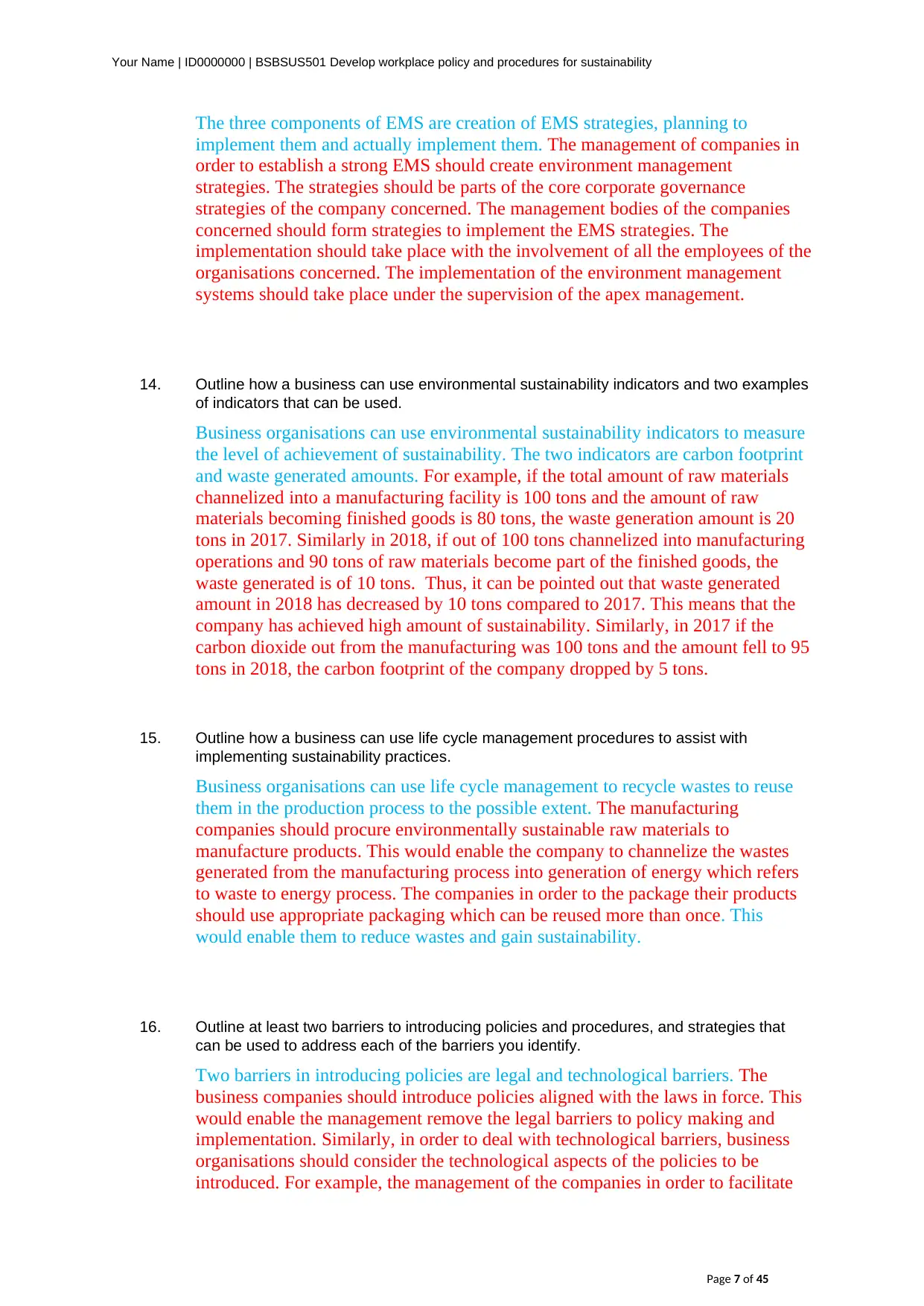
Your Name | ID0000000 | BSBSUS501 Develop workplace policy and procedures for sustainability
The three components of EMS are creation of EMS strategies, planning to
implement them and actually implement them. The management of companies in
order to establish a strong EMS should create environment management
strategies. The strategies should be parts of the core corporate governance
strategies of the company concerned. The management bodies of the companies
concerned should form strategies to implement the EMS strategies. The
implementation should take place with the involvement of all the employees of the
organisations concerned. The implementation of the environment management
systems should take place under the supervision of the apex management.
14. Outline how a business can use environmental sustainability indicators and two examples
of indicators that can be used.
Business organisations can use environmental sustainability indicators to measure
the level of achievement of sustainability. The two indicators are carbon footprint
and waste generated amounts. For example, if the total amount of raw materials
channelized into a manufacturing facility is 100 tons and the amount of raw
materials becoming finished goods is 80 tons, the waste generation amount is 20
tons in 2017. Similarly in 2018, if out of 100 tons channelized into manufacturing
operations and 90 tons of raw materials become part of the finished goods, the
waste generated is of 10 tons. Thus, it can be pointed out that waste generated
amount in 2018 has decreased by 10 tons compared to 2017. This means that the
company has achieved high amount of sustainability. Similarly, in 2017 if the
carbon dioxide out from the manufacturing was 100 tons and the amount fell to 95
tons in 2018, the carbon footprint of the company dropped by 5 tons.
15. Outline how a business can use life cycle management procedures to assist with
implementing sustainability practices.
Business organisations can use life cycle management to recycle wastes to reuse
them in the production process to the possible extent. The manufacturing
companies should procure environmentally sustainable raw materials to
manufacture products. This would enable the company to channelize the wastes
generated from the manufacturing process into generation of energy which refers
to waste to energy process. The companies in order to the package their products
should use appropriate packaging which can be reused more than once. This
would enable them to reduce wastes and gain sustainability.
16. Outline at least two barriers to introducing policies and procedures, and strategies that
can be used to address each of the barriers you identify.
Two barriers in introducing policies are legal and technological barriers. The
business companies should introduce policies aligned with the laws in force. This
would enable the management remove the legal barriers to policy making and
implementation. Similarly, in order to deal with technological barriers, business
organisations should consider the technological aspects of the policies to be
introduced. For example, the management of the companies in order to facilitate
Page 7 of 45
The three components of EMS are creation of EMS strategies, planning to
implement them and actually implement them. The management of companies in
order to establish a strong EMS should create environment management
strategies. The strategies should be parts of the core corporate governance
strategies of the company concerned. The management bodies of the companies
concerned should form strategies to implement the EMS strategies. The
implementation should take place with the involvement of all the employees of the
organisations concerned. The implementation of the environment management
systems should take place under the supervision of the apex management.
14. Outline how a business can use environmental sustainability indicators and two examples
of indicators that can be used.
Business organisations can use environmental sustainability indicators to measure
the level of achievement of sustainability. The two indicators are carbon footprint
and waste generated amounts. For example, if the total amount of raw materials
channelized into a manufacturing facility is 100 tons and the amount of raw
materials becoming finished goods is 80 tons, the waste generation amount is 20
tons in 2017. Similarly in 2018, if out of 100 tons channelized into manufacturing
operations and 90 tons of raw materials become part of the finished goods, the
waste generated is of 10 tons. Thus, it can be pointed out that waste generated
amount in 2018 has decreased by 10 tons compared to 2017. This means that the
company has achieved high amount of sustainability. Similarly, in 2017 if the
carbon dioxide out from the manufacturing was 100 tons and the amount fell to 95
tons in 2018, the carbon footprint of the company dropped by 5 tons.
15. Outline how a business can use life cycle management procedures to assist with
implementing sustainability practices.
Business organisations can use life cycle management to recycle wastes to reuse
them in the production process to the possible extent. The manufacturing
companies should procure environmentally sustainable raw materials to
manufacture products. This would enable the company to channelize the wastes
generated from the manufacturing process into generation of energy which refers
to waste to energy process. The companies in order to the package their products
should use appropriate packaging which can be reused more than once. This
would enable them to reduce wastes and gain sustainability.
16. Outline at least two barriers to introducing policies and procedures, and strategies that
can be used to address each of the barriers you identify.
Two barriers in introducing policies are legal and technological barriers. The
business companies should introduce policies aligned with the laws in force. This
would enable the management remove the legal barriers to policy making and
implementation. Similarly, in order to deal with technological barriers, business
organisations should consider the technological aspects of the policies to be
introduced. For example, the management of the companies in order to facilitate
Page 7 of 45
Paraphrase This Document
Need a fresh take? Get an instant paraphrase of this document with our AI Paraphraser
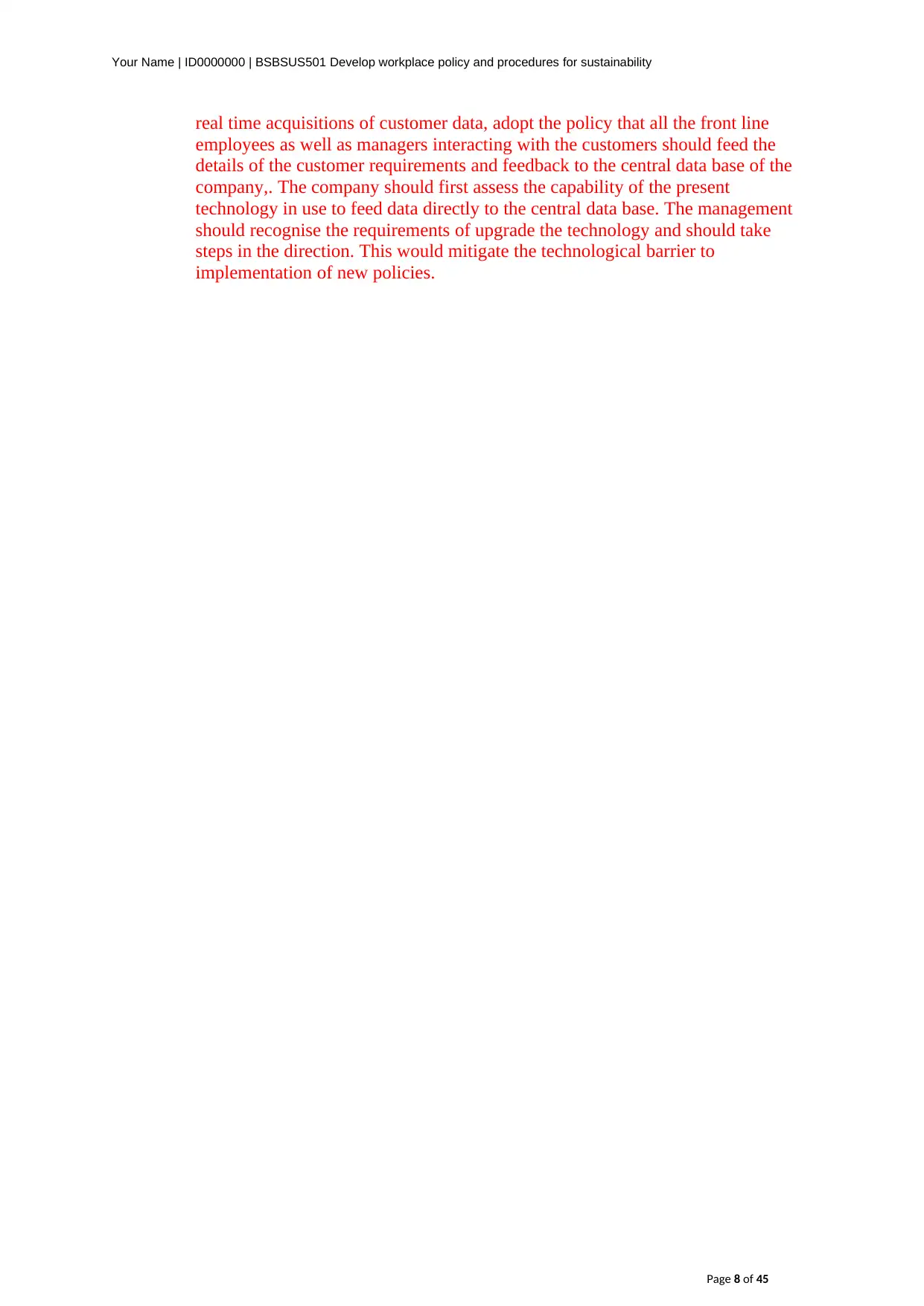
Your Name | ID0000000 | BSBSUS501 Develop workplace policy and procedures for sustainability
real time acquisitions of customer data, adopt the policy that all the front line
employees as well as managers interacting with the customers should feed the
details of the customer requirements and feedback to the central data base of the
company,. The company should first assess the capability of the present
technology in use to feed data directly to the central data base. The management
should recognise the requirements of upgrade the technology and should take
steps in the direction. This would mitigate the technological barrier to
implementation of new policies.
Page 8 of 45
real time acquisitions of customer data, adopt the policy that all the front line
employees as well as managers interacting with the customers should feed the
details of the customer requirements and feedback to the central data base of the
company,. The company should first assess the capability of the present
technology in use to feed data directly to the central data base. The management
should recognise the requirements of upgrade the technology and should take
steps in the direction. This would mitigate the technological barrier to
implementation of new policies.
Page 8 of 45
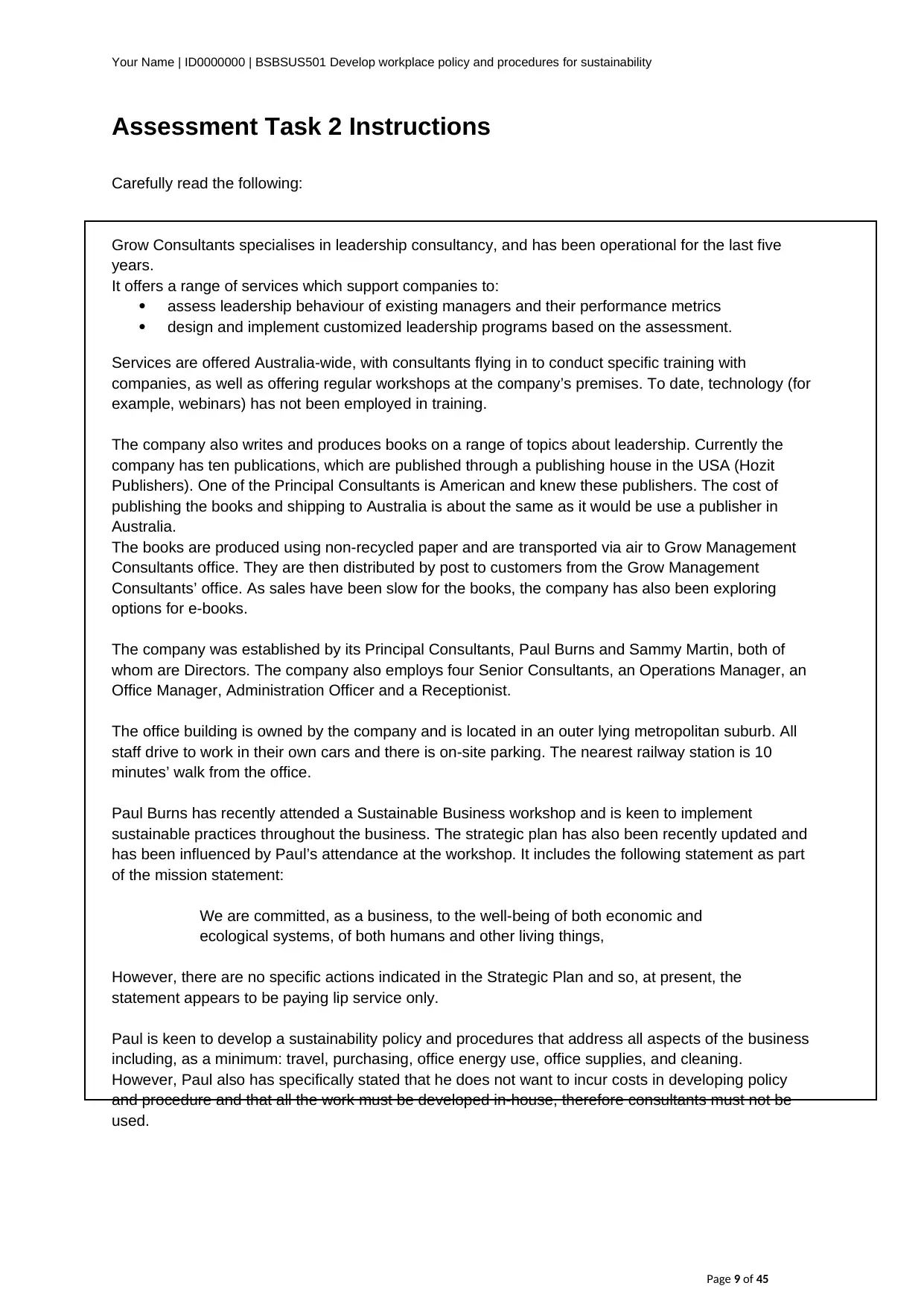
Your Name | ID0000000 | BSBSUS501 Develop workplace policy and procedures for sustainability
Assessment Task 2 Instructions
Carefully read the following:
Grow Consultants specialises in leadership consultancy, and has been operational for the last five
years.
It offers a range of services which support companies to:
assess leadership behaviour of existing managers and their performance metrics
design and implement customized leadership programs based on the assessment.
Services are offered Australia-wide, with consultants flying in to conduct specific training with
companies, as well as offering regular workshops at the company’s premises. To date, technology (for
example, webinars) has not been employed in training.
The company also writes and produces books on a range of topics about leadership. Currently the
company has ten publications, which are published through a publishing house in the USA (Hozit
Publishers). One of the Principal Consultants is American and knew these publishers. The cost of
publishing the books and shipping to Australia is about the same as it would be use a publisher in
Australia.
The books are produced using non-recycled paper and are transported via air to Grow Management
Consultants office. They are then distributed by post to customers from the Grow Management
Consultants’ office. As sales have been slow for the books, the company has also been exploring
options for e-books.
The company was established by its Principal Consultants, Paul Burns and Sammy Martin, both of
whom are Directors. The company also employs four Senior Consultants, an Operations Manager, an
Office Manager, Administration Officer and a Receptionist.
The office building is owned by the company and is located in an outer lying metropolitan suburb. All
staff drive to work in their own cars and there is on-site parking. The nearest railway station is 10
minutes’ walk from the office.
Paul Burns has recently attended a Sustainable Business workshop and is keen to implement
sustainable practices throughout the business. The strategic plan has also been recently updated and
has been influenced by Paul’s attendance at the workshop. It includes the following statement as part
of the mission statement:
We are committed, as a business, to the well-being of both economic and
ecological systems, of both humans and other living things,
However, there are no specific actions indicated in the Strategic Plan and so, at present, the
statement appears to be paying lip service only.
Paul is keen to develop a sustainability policy and procedures that address all aspects of the business
including, as a minimum: travel, purchasing, office energy use, office supplies, and cleaning.
However, Paul also has specifically stated that he does not want to incur costs in developing policy
and procedure and that all the work must be developed in-house, therefore consultants must not be
used.
Page 9 of 45
Assessment Task 2 Instructions
Carefully read the following:
Grow Consultants specialises in leadership consultancy, and has been operational for the last five
years.
It offers a range of services which support companies to:
assess leadership behaviour of existing managers and their performance metrics
design and implement customized leadership programs based on the assessment.
Services are offered Australia-wide, with consultants flying in to conduct specific training with
companies, as well as offering regular workshops at the company’s premises. To date, technology (for
example, webinars) has not been employed in training.
The company also writes and produces books on a range of topics about leadership. Currently the
company has ten publications, which are published through a publishing house in the USA (Hozit
Publishers). One of the Principal Consultants is American and knew these publishers. The cost of
publishing the books and shipping to Australia is about the same as it would be use a publisher in
Australia.
The books are produced using non-recycled paper and are transported via air to Grow Management
Consultants office. They are then distributed by post to customers from the Grow Management
Consultants’ office. As sales have been slow for the books, the company has also been exploring
options for e-books.
The company was established by its Principal Consultants, Paul Burns and Sammy Martin, both of
whom are Directors. The company also employs four Senior Consultants, an Operations Manager, an
Office Manager, Administration Officer and a Receptionist.
The office building is owned by the company and is located in an outer lying metropolitan suburb. All
staff drive to work in their own cars and there is on-site parking. The nearest railway station is 10
minutes’ walk from the office.
Paul Burns has recently attended a Sustainable Business workshop and is keen to implement
sustainable practices throughout the business. The strategic plan has also been recently updated and
has been influenced by Paul’s attendance at the workshop. It includes the following statement as part
of the mission statement:
We are committed, as a business, to the well-being of both economic and
ecological systems, of both humans and other living things,
However, there are no specific actions indicated in the Strategic Plan and so, at present, the
statement appears to be paying lip service only.
Paul is keen to develop a sustainability policy and procedures that address all aspects of the business
including, as a minimum: travel, purchasing, office energy use, office supplies, and cleaning.
However, Paul also has specifically stated that he does not want to incur costs in developing policy
and procedure and that all the work must be developed in-house, therefore consultants must not be
used.
Page 9 of 45
⊘ This is a preview!⊘
Do you want full access?
Subscribe today to unlock all pages.

Trusted by 1+ million students worldwide
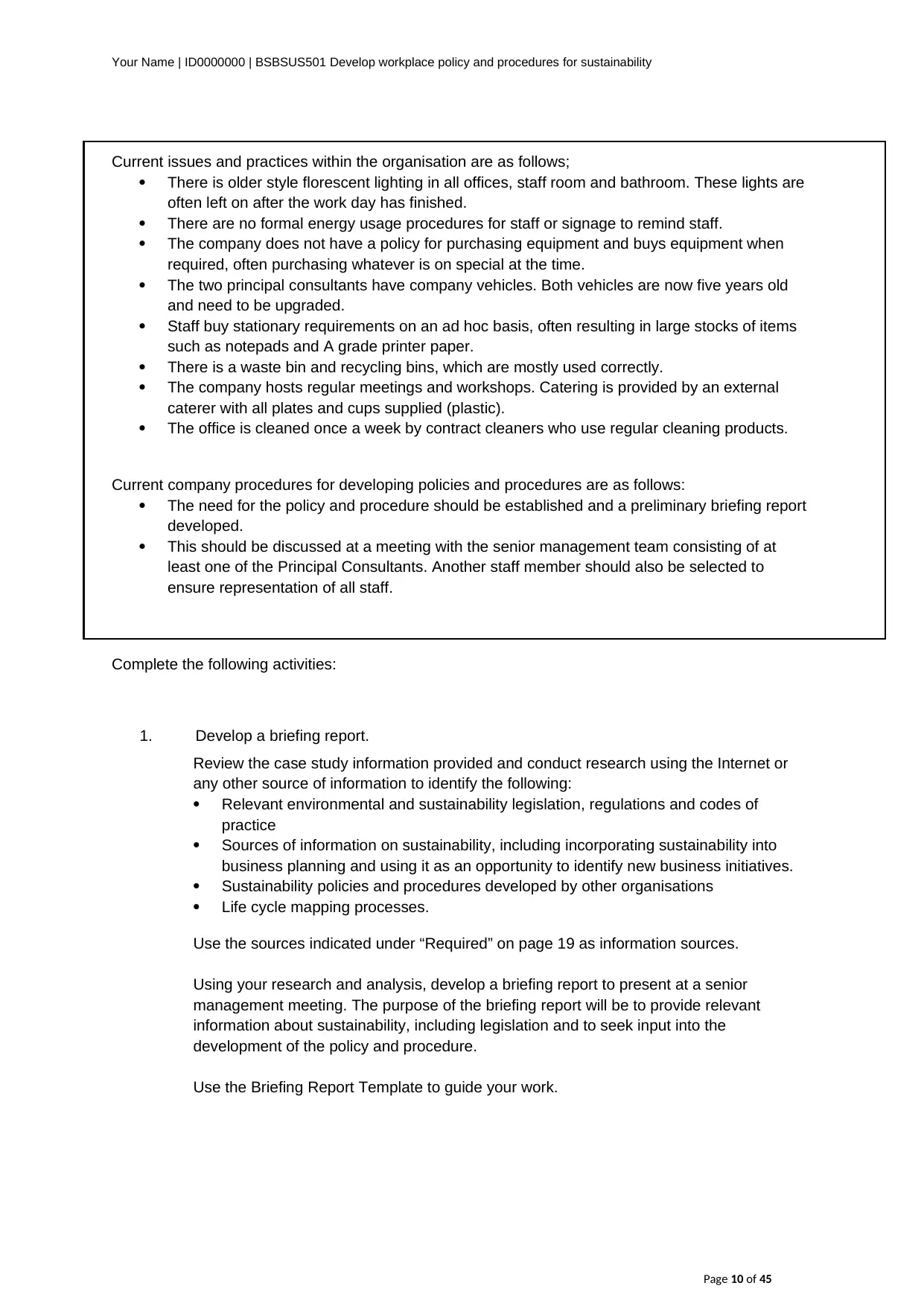
Your Name | ID0000000 | BSBSUS501 Develop workplace policy and procedures for sustainability
Current issues and practices within the organisation are as follows;
There is older style florescent lighting in all offices, staff room and bathroom. These lights are
often left on after the work day has finished.
There are no formal energy usage procedures for staff or signage to remind staff.
The company does not have a policy for purchasing equipment and buys equipment when
required, often purchasing whatever is on special at the time.
The two principal consultants have company vehicles. Both vehicles are now five years old
and need to be upgraded.
Staff buy stationary requirements on an ad hoc basis, often resulting in large stocks of items
such as notepads and A grade printer paper.
There is a waste bin and recycling bins, which are mostly used correctly.
The company hosts regular meetings and workshops. Catering is provided by an external
caterer with all plates and cups supplied (plastic).
The office is cleaned once a week by contract cleaners who use regular cleaning products.
Current company procedures for developing policies and procedures are as follows:
The need for the policy and procedure should be established and a preliminary briefing report
developed.
This should be discussed at a meeting with the senior management team consisting of at
least one of the Principal Consultants. Another staff member should also be selected to
ensure representation of all staff.
Complete the following activities:
1. Develop a briefing report.
Review the case study information provided and conduct research using the Internet or
any other source of information to identify the following:
Relevant environmental and sustainability legislation, regulations and codes of
practice
Sources of information on sustainability, including incorporating sustainability into
business planning and using it as an opportunity to identify new business initiatives.
Sustainability policies and procedures developed by other organisations
Life cycle mapping processes.
Use the sources indicated under “Required” on page 19 as information sources.
Using your research and analysis, develop a briefing report to present at a senior
management meeting. The purpose of the briefing report will be to provide relevant
information about sustainability, including legislation and to seek input into the
development of the policy and procedure.
Use the Briefing Report Template to guide your work.
Page 10 of 45
Current issues and practices within the organisation are as follows;
There is older style florescent lighting in all offices, staff room and bathroom. These lights are
often left on after the work day has finished.
There are no formal energy usage procedures for staff or signage to remind staff.
The company does not have a policy for purchasing equipment and buys equipment when
required, often purchasing whatever is on special at the time.
The two principal consultants have company vehicles. Both vehicles are now five years old
and need to be upgraded.
Staff buy stationary requirements on an ad hoc basis, often resulting in large stocks of items
such as notepads and A grade printer paper.
There is a waste bin and recycling bins, which are mostly used correctly.
The company hosts regular meetings and workshops. Catering is provided by an external
caterer with all plates and cups supplied (plastic).
The office is cleaned once a week by contract cleaners who use regular cleaning products.
Current company procedures for developing policies and procedures are as follows:
The need for the policy and procedure should be established and a preliminary briefing report
developed.
This should be discussed at a meeting with the senior management team consisting of at
least one of the Principal Consultants. Another staff member should also be selected to
ensure representation of all staff.
Complete the following activities:
1. Develop a briefing report.
Review the case study information provided and conduct research using the Internet or
any other source of information to identify the following:
Relevant environmental and sustainability legislation, regulations and codes of
practice
Sources of information on sustainability, including incorporating sustainability into
business planning and using it as an opportunity to identify new business initiatives.
Sustainability policies and procedures developed by other organisations
Life cycle mapping processes.
Use the sources indicated under “Required” on page 19 as information sources.
Using your research and analysis, develop a briefing report to present at a senior
management meeting. The purpose of the briefing report will be to provide relevant
information about sustainability, including legislation and to seek input into the
development of the policy and procedure.
Use the Briefing Report Template to guide your work.
Page 10 of 45
Paraphrase This Document
Need a fresh take? Get an instant paraphrase of this document with our AI Paraphraser
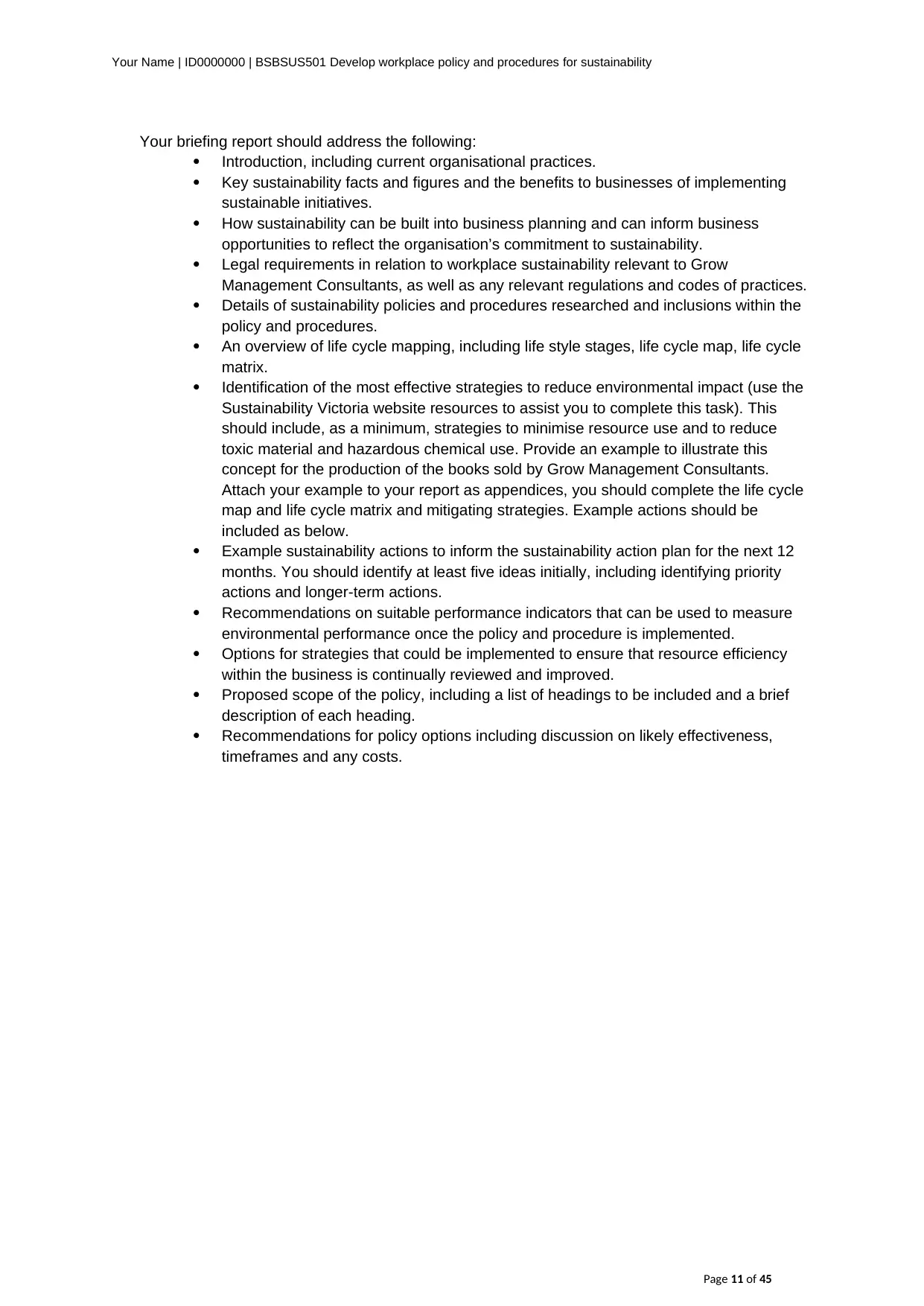
Your Name | ID0000000 | BSBSUS501 Develop workplace policy and procedures for sustainability
Your briefing report should address the following:
Introduction, including current organisational practices.
Key sustainability facts and figures and the benefits to businesses of implementing
sustainable initiatives.
How sustainability can be built into business planning and can inform business
opportunities to reflect the organisation’s commitment to sustainability.
Legal requirements in relation to workplace sustainability relevant to Grow
Management Consultants, as well as any relevant regulations and codes of practices.
Details of sustainability policies and procedures researched and inclusions within the
policy and procedures.
An overview of life cycle mapping, including life style stages, life cycle map, life cycle
matrix.
Identification of the most effective strategies to reduce environmental impact (use the
Sustainability Victoria website resources to assist you to complete this task). This
should include, as a minimum, strategies to minimise resource use and to reduce
toxic material and hazardous chemical use. Provide an example to illustrate this
concept for the production of the books sold by Grow Management Consultants.
Attach your example to your report as appendices, you should complete the life cycle
map and life cycle matrix and mitigating strategies. Example actions should be
included as below.
Example sustainability actions to inform the sustainability action plan for the next 12
months. You should identify at least five ideas initially, including identifying priority
actions and longer-term actions.
Recommendations on suitable performance indicators that can be used to measure
environmental performance once the policy and procedure is implemented.
Options for strategies that could be implemented to ensure that resource efficiency
within the business is continually reviewed and improved.
Proposed scope of the policy, including a list of headings to be included and a brief
description of each heading.
Recommendations for policy options including discussion on likely effectiveness,
timeframes and any costs.
Page 11 of 45
Your briefing report should address the following:
Introduction, including current organisational practices.
Key sustainability facts and figures and the benefits to businesses of implementing
sustainable initiatives.
How sustainability can be built into business planning and can inform business
opportunities to reflect the organisation’s commitment to sustainability.
Legal requirements in relation to workplace sustainability relevant to Grow
Management Consultants, as well as any relevant regulations and codes of practices.
Details of sustainability policies and procedures researched and inclusions within the
policy and procedures.
An overview of life cycle mapping, including life style stages, life cycle map, life cycle
matrix.
Identification of the most effective strategies to reduce environmental impact (use the
Sustainability Victoria website resources to assist you to complete this task). This
should include, as a minimum, strategies to minimise resource use and to reduce
toxic material and hazardous chemical use. Provide an example to illustrate this
concept for the production of the books sold by Grow Management Consultants.
Attach your example to your report as appendices, you should complete the life cycle
map and life cycle matrix and mitigating strategies. Example actions should be
included as below.
Example sustainability actions to inform the sustainability action plan for the next 12
months. You should identify at least five ideas initially, including identifying priority
actions and longer-term actions.
Recommendations on suitable performance indicators that can be used to measure
environmental performance once the policy and procedure is implemented.
Options for strategies that could be implemented to ensure that resource efficiency
within the business is continually reviewed and improved.
Proposed scope of the policy, including a list of headings to be included and a brief
description of each heading.
Recommendations for policy options including discussion on likely effectiveness,
timeframes and any costs.
Page 11 of 45
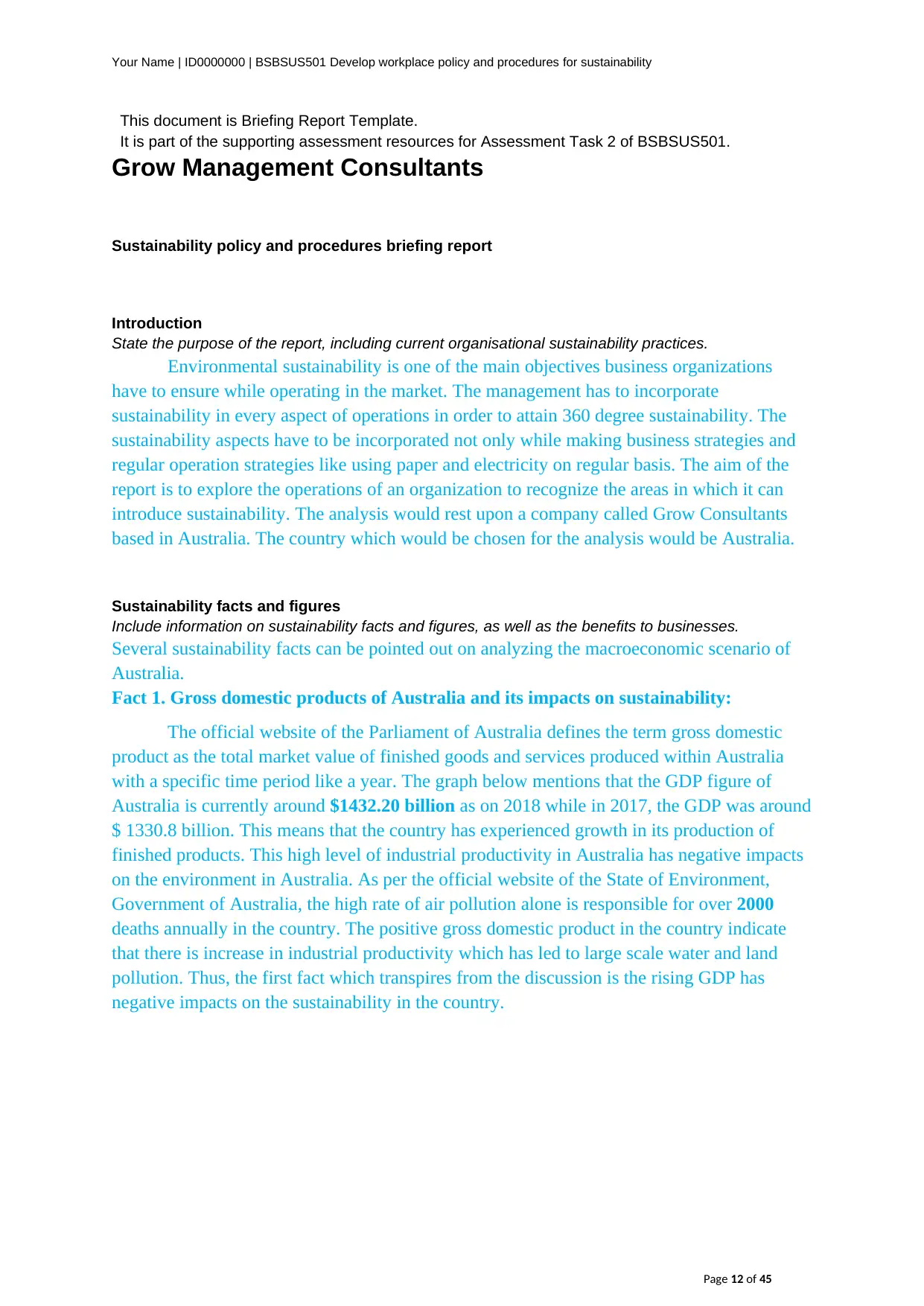
Your Name | ID0000000 | BSBSUS501 Develop workplace policy and procedures for sustainability
This document is Briefing Report Template.
It is part of the supporting assessment resources for Assessment Task 2 of BSBSUS501.
Grow Management Consultants
Sustainability policy and procedures briefing report
Introduction
State the purpose of the report, including current organisational sustainability practices.
Environmental sustainability is one of the main objectives business organizations
have to ensure while operating in the market. The management has to incorporate
sustainability in every aspect of operations in order to attain 360 degree sustainability. The
sustainability aspects have to be incorporated not only while making business strategies and
regular operation strategies like using paper and electricity on regular basis. The aim of the
report is to explore the operations of an organization to recognize the areas in which it can
introduce sustainability. The analysis would rest upon a company called Grow Consultants
based in Australia. The country which would be chosen for the analysis would be Australia.
Sustainability facts and figures
Include information on sustainability facts and figures, as well as the benefits to businesses.
Several sustainability facts can be pointed out on analyzing the macroeconomic scenario of
Australia.
Fact 1. Gross domestic products of Australia and its impacts on sustainability:
The official website of the Parliament of Australia defines the term gross domestic
product as the total market value of finished goods and services produced within Australia
with a specific time period like a year. The graph below mentions that the GDP figure of
Australia is currently around $1432.20 billion as on 2018 while in 2017, the GDP was around
$ 1330.8 billion. This means that the country has experienced growth in its production of
finished products. This high level of industrial productivity in Australia has negative impacts
on the environment in Australia. As per the official website of the State of Environment,
Government of Australia, the high rate of air pollution alone is responsible for over 2000
deaths annually in the country. The positive gross domestic product in the country indicate
that there is increase in industrial productivity which has led to large scale water and land
pollution. Thus, the first fact which transpires from the discussion is the rising GDP has
negative impacts on the sustainability in the country.
Page 12 of 45
This document is Briefing Report Template.
It is part of the supporting assessment resources for Assessment Task 2 of BSBSUS501.
Grow Management Consultants
Sustainability policy and procedures briefing report
Introduction
State the purpose of the report, including current organisational sustainability practices.
Environmental sustainability is one of the main objectives business organizations
have to ensure while operating in the market. The management has to incorporate
sustainability in every aspect of operations in order to attain 360 degree sustainability. The
sustainability aspects have to be incorporated not only while making business strategies and
regular operation strategies like using paper and electricity on regular basis. The aim of the
report is to explore the operations of an organization to recognize the areas in which it can
introduce sustainability. The analysis would rest upon a company called Grow Consultants
based in Australia. The country which would be chosen for the analysis would be Australia.
Sustainability facts and figures
Include information on sustainability facts and figures, as well as the benefits to businesses.
Several sustainability facts can be pointed out on analyzing the macroeconomic scenario of
Australia.
Fact 1. Gross domestic products of Australia and its impacts on sustainability:
The official website of the Parliament of Australia defines the term gross domestic
product as the total market value of finished goods and services produced within Australia
with a specific time period like a year. The graph below mentions that the GDP figure of
Australia is currently around $1432.20 billion as on 2018 while in 2017, the GDP was around
$ 1330.8 billion. This means that the country has experienced growth in its production of
finished products. This high level of industrial productivity in Australia has negative impacts
on the environment in Australia. As per the official website of the State of Environment,
Government of Australia, the high rate of air pollution alone is responsible for over 2000
deaths annually in the country. The positive gross domestic product in the country indicate
that there is increase in industrial productivity which has led to large scale water and land
pollution. Thus, the first fact which transpires from the discussion is the rising GDP has
negative impacts on the sustainability in the country.
Page 12 of 45
⊘ This is a preview!⊘
Do you want full access?
Subscribe today to unlock all pages.

Trusted by 1+ million students worldwide
1 out of 45
Related Documents
Your All-in-One AI-Powered Toolkit for Academic Success.
+13062052269
info@desklib.com
Available 24*7 on WhatsApp / Email
![[object Object]](/_next/static/media/star-bottom.7253800d.svg)
Unlock your academic potential
Copyright © 2020–2025 A2Z Services. All Rights Reserved. Developed and managed by ZUCOL.





